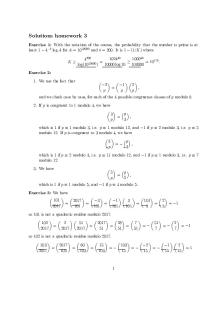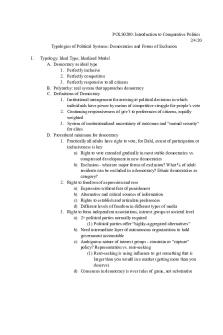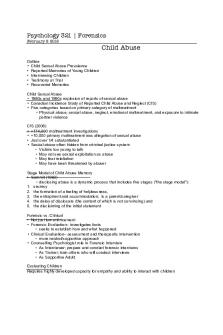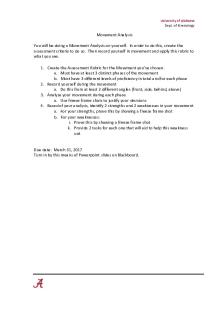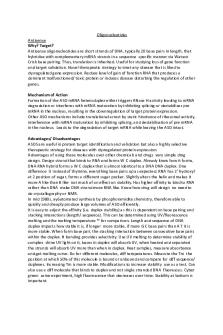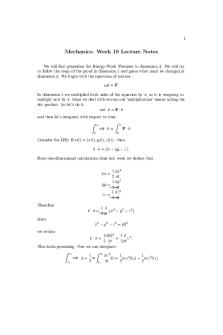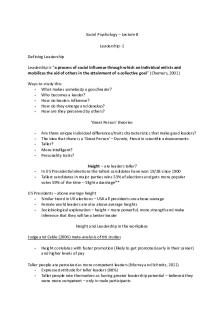Settler Colonialism - Taught by Kevin Escudero PDF

| Title | Settler Colonialism - Taught by Kevin Escudero |
|---|---|
| Course | Introduction to American Ethnic Studies |
| Institution | Brown University |
| Pages | 3 |
| File Size | 68.3 KB |
| File Type | |
| Total Downloads | 47 |
| Total Views | 149 |
Summary
Taught by Kevin Escudero...
Description
Settler Colonialism 1. Defining Settler Colonialism 1. Settler Colonialism - The specific formation of colonialism in which people come to a land inhabited by indigenous people and declare that land to be their new home. 1. About the pursuit of land, not just labor or resources… persistent societal structure, not just historical event or origins story for a nation-state (ongoing, not historical) 2. Has meant the genocide of indigenous peoples, the reconfiguration of indigenous land into settler property. In the US, it has also meant the theft of people from their homeland to become property of settlers to labor on stolen land. Think: taking a land and writing yourself into the history of it. 2. Understood as relating to 3 specific areas: 1. Land 1. Acquiring land not solely to extract resources, but to inhabit and live on the land (to replace the indigenous peoples already living on the land) 2. Erasure of indigeneity and indigenous peoples 1. Erasure of indigenous ways of life and indigenous peoples 3. Racial capitalism 1. Settlers employing the use of a capitalist logic to benefit from the labor of indigenous peoples who have been disposed of their land and settlers of color (immigrants, refugees, etc.) 2. Setter Colonialism as a Race-Gender Project 1. Transplanted certain racialized and genders conceptions and regimes… what merged out of settler colonial project was a racialized and gendered national identity that normalized male whiteness 1. Racial component: conceptions of indigenous peoples as racially inferior allowed for white settlers to make land claims 1. Furthered the notion of empty land or the taking pg. 58 2. Gendered component: centering of heteropatric kinship relations 1. Masculine whiteness became central to settler identity which rendered white manhood supreme 3. Intrasettler Racism 1. Concept developed by Kanaka Maoli scholar 1. Used to describe the racism that settlers of color experience from white settlers 2. Distinguished from the genocide and racism that indigenous peoples face 3. Points to the complex terrains of marginalize and subjugation that operate across space and within communities
2. Experiencing racism and discrimination from the US society, but its not the same as genocide and the kinds of discrimination indigenous peoples face. 1. Not oppression Olympics, but examines the complex ways various forms of oppression interact and intersect 4. Importance of Centering Indigenous Peoples 1. Setter colonialism as a project should not focus solely on the experience of settlers and their tole in the dispossession of indigenous peoples lives 1. Developed the concept of enduring indigeneity 1. Refers to 2 processes: 1. Indigeneity itself is enduring 2. Settler colonialism is a structure that endures indigeneity, as it holds out against it 1. Settler Colonialism in Action: Guam v. Davis Case 1. Guam 1. US territory in the pacific 1. Part of Micronesia 1. Along with the commonwealth of the Northern Mariana Islands forms the Marianas archipelago 2. First colonized by Spain 1. Later became a US territory in 1898 with the signing of the Treaty of Paris 2. 1/3 of island is occupied by US military bases 2. Davis v. Guam case 1. Court case filed by former Guam, non indigenous (Chamorros) resident, Arnold Davis 2. Davis claimed infringement of his voting rights due to his ineligible to vote in plebiscite case 1. Plebiscite vote mean to poll Chamorro residents regarding their options for sovereignty and self-determination (plebiscite is referendum, non-binding vote that would show support to the US gov't) 1. Voter options were independence, statehood, or free association 2. Voter eligibility was determined based on ability to trace your heritage to individuals resident on the island prior to the signing of the Organic Act of 1950 which granted US citizenship to residents 3. Plebiscite meant to remedy historical injustice 3. District court ruled for Davis but noted that the issue could be revisited later
4. Guam appealed to the 9th circuit 1. 9th circuit also sided with Davis 1. Held that the plebiscite eligibility interfered with voting rights protections under the Constitution's 15th amendment 5. 15th amendment meant to ensure right to vote for formerly enslaved 1. Turns the logic of voting right and who the legislation is meant to protect on its head 6. Next step: Guam governor decided to appeal to SCOTUS 1. If court does hear it, impact would be seen in the rights of indigenous peoples in the US today, re-fashioning of a US civil rights framework that incorporates an analysis of settler colonialism and indigenous sovereignty 2. Key Takeaways 1. Settler colonialism is a violent, ongoing process 2. Settler colonialism is alive and well as part of the US imperialist project 3. Indigenous resurgence and decolonization is ongoing 1. Folks are actively fighting, using the supreme court… but it's hard when playing in the framework of the settler state 4. In the decolonization process it is important and necessary to center the selfdetermination of indigenous peoples and their relationships to the various settlers in their community 1. Make sure to center the experiences of indigenous perspective even when talking about other marginalized communities… how do we develop that relationship?...
Similar Free PDFs
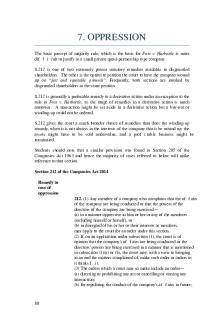
7. Oppression - Taught by John Quinn
- 10 Pages
Popular Institutions
- Tinajero National High School - Annex
- Politeknik Caltex Riau
- Yokohama City University
- SGT University
- University of Al-Qadisiyah
- Divine Word College of Vigan
- Techniek College Rotterdam
- Universidade de Santiago
- Universiti Teknologi MARA Cawangan Johor Kampus Pasir Gudang
- Poltekkes Kemenkes Yogyakarta
- Baguio City National High School
- Colegio san marcos
- preparatoria uno
- Centro de Bachillerato Tecnológico Industrial y de Servicios No. 107
- Dalian Maritime University
- Quang Trung Secondary School
- Colegio Tecnológico en Informática
- Corporación Regional de Educación Superior
- Grupo CEDVA
- Dar Al Uloom University
- Centro de Estudios Preuniversitarios de la Universidad Nacional de Ingeniería
- 上智大学
- Aakash International School, Nuna Majara
- San Felipe Neri Catholic School
- Kang Chiao International School - New Taipei City
- Misamis Occidental National High School
- Institución Educativa Escuela Normal Juan Ladrilleros
- Kolehiyo ng Pantukan
- Batanes State College
- Instituto Continental
- Sekolah Menengah Kejuruan Kesehatan Kaltara (Tarakan)
- Colegio de La Inmaculada Concepcion - Cebu




